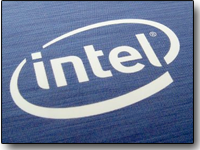Intel Sports Working Moorestown at Computex
Intel's senior vice president Anand Chandrasekher displayed a few prototype mobile Internet devices (MIDs) powered by the company's upcoming Moorestown chip platform.
On Thursday, Intel's senior vice president Anand Chandrasekher displayed a few prototype mobile Internet devices (MIDs) powered by the company's upcoming Moorestown chip platform. Designed for handheld computers, the platform comprises of the Lincroft Atom processor (which crams a 45 nm processor, graphics, memory controller and video encode/decode onto a single chip) and the accompanying Langwell I/O hub. According to Intel, the Moorestown platform uses less idle power than the current Menlow platform, one-fiftieth to be exact, and will be available with a variety of wireless options (3G, WiMAX, Wi-Fi, GPS, Bluetooth, Mobile TV) when it eventually goes to retail.
During the presentation, Inventec Appliances, Quanta Computer and Elektrobit showcased mobile devices utilizing the Moorestown platform and the Moblin 2.0 version of Linux. Executives representing all three companies claimed that the retail version should be available on the market sometime early 2010. Computerworld also quoted an unnamed source, revealing that engineers managed to get the three prototypes up and running for Computex in less than two months; Intel, unfortunately, actually hoped five models would be available for public viewing.
For now, the Moorestown chips are only available as samples. "We're not yet in [volume] production. We're getting close," Chandrasekher said in his speech. The reigning MID Menlow platform is still currently being used in new designs, and is expected to continue on next year and possibly overlap the Moorestown platform when it becomes available.
Intel originally revealed the Moorestown platform back in October 2008 during the Intel Developer Forum keynote speech.
Get Tom's Hardware's best news and in-depth reviews, straight to your inbox.

Kevin Parrish has over a decade of experience as a writer, editor, and product tester. His work focused on computer hardware, networking equipment, smartphones, tablets, gaming consoles, and other internet-connected devices. His work has appeared in Tom's Hardware, Tom's Guide, Maximum PC, Digital Trends, Android Authority, How-To Geek, Lifewire, and others.
-
bucifer Replyuses less idle power than the current Menlow platform, one-fiftieth to be exact,
Is this a typo? Isn't there a suggestion on the feedback forum to improve the quality of the articles. I guess tom is getting more and more trash news. Quantity over quality won't get you anywhere. -
Marcus Yam buciferIs this a typo? Isn't there a suggestion on the feedback forum to improve the quality of the articles. I guess tom is getting more and more trash news. Quantity over quality won't get you anywhere.Hi bucifer,Reply
The Computerworld story linked in the article does explicitly read, "Intel claims Moorestown uses one-fiftieth the idle power of its predecessor, the Menlow platform." So, as far as I am aware, the story is accurate as long as Computerworld hasn't mixed up its numbers.
Hopefully they're right, as having one-fiftieth the idle power would be pretty amazing -- perhaps to the point of disbelief!
Thanks for reading and, as always, thanks for your feedback. -
It's just comparing the all on one chip (aimed at 1 Watt), vs a Celeron/Core2Duo's 50Watt platform.Reply
It certainly is no performance monster but has enough juice to do most common jobs.
The chip can be compared to the performance of lower ARM processors found in ebook readers. -
The Schnoz I hate the atom, but mostly for the chipset. This sounded sort of interesting in October, but now it sounds like a game changer. I also can't wait to see AMD's Fusion.Reply
